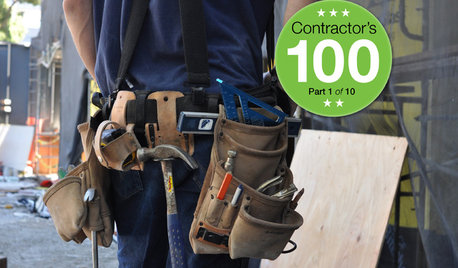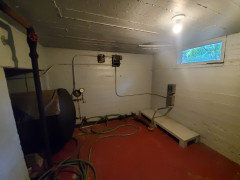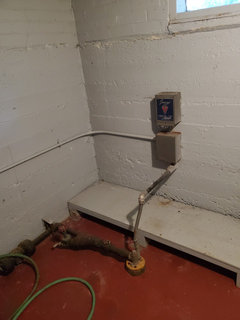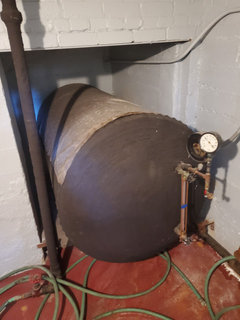Considering multiple proposals for AC &backup heat for our 95yo home
A Fox
2 years ago
last modified: 2 years ago
Featured Answer
Comments (48)
fsq4cw
2 years agoCharles Ross Homes
2 years agoRelated Discussions
time for new heat and central a/c - 'upgrade' frm LP to heatpump?
Comments (24)A properly sized unit should be able to maintain reasonable humidity levels (though maybe not at 78 degrees without a dehumidification mode). The dual-stage unit will help control humidity. The only way of extra dehumidification with the XL16i that I know of is with the TCONT803/Honeywell TH8321 thermostat, which will overcool to control humidity. Ask your contractor why he proposed the VisionPRO IAQ when the BK terminal is already in use by the XL16i, thus not allowing the dehumidification feature of the VisionPRO IAQ (which is great as it actually slows down the blower). If you want an alternative that can make use of the VisionPRO IAQ, I'd go with the XL15i. It's a single-stage unit, but sized properly it should control humidity fine with the added advantage of the VisionPRO IAQ. Here are possible setups (ask your contractor what size he would recommend--I would NOT go with a 3 ton for your size home). Now, there are different air handlers that can go with these units, but the 4TEE3F39 air handler is tall due to the Vortica blower. The 4TWX5024A1000A (2-ton XL15i) with the 4TEE3F31B1000A yields 13.00 EER, 15.25 SEER and 8.60 HSPF. The 4TWX5024A1000A (2-ton XL15i) with the 4TEE3F39A1000A yields 13.00 EER, 16.00 SEER, and 9.00 HSPF. The 4TWX5018A1000A (1.5-ton XL15i) with the 4TEE3F31B1000A (only rated match with the 1.5-ton outdoor unit) yields 13.00 EER, 15.00 HSPF, and 8.50 HSPF. Feel free to print out my responses if it will be easier for you to go over these possible issues with your contractor. Good luck....See MoreLennox vs Tempstar AC/Heating Unit
Comments (17)Just received the following proposal. There is some variation in the model numbers YOU gave me, Tigerdunes. I would really appreciate your thoughts. Base Price: $6140.00 Lennox CBX32MV-036 R410A Vari Speed Air Handler Lennox XP14-030 15 SEER/12.5 EER/8.5 HSPF Heat Pump Lennox 34W87 5kW Strip Heat for Air Handler EZ Filter 20" x 25" Furnace Filter Rack w/filter 2 Diversitech 30 AMP Electrical Disconnects 1 Honeywell Focus Pro 6000 Digital Thermostat 1 Crane Service to Roof Remove & dispose of existing system, insulate platform, clear condensates, condensate safety switch, add filter driers, thermostat, crane service to roof, new electrical disconnects, start up & run test new system System Warranty: Parts: 10 yrs Labor: 2 yrs Compressor 10 yrs Heat Exchanger -- The above also includes the following: Freon recovery Copper Puron lines Prmary condensate drain 220 volt circuit w/disconnect Qualifies for 2010 Tax credit up to $1500 Is this a good system?...See MoreStandard a/c or Unico for 100 yr old house
Comments (15)Thanks brickeyee & airsome. This is a rowhouse with a flat roof, and in our neighborhood pretty much everyone's condensor goes on the roof, b/c the backyards are small & you can't stick the noisy condensor right under your neighbor's window. That being said, not many have central A/C. Are condensors the same size for Unico as for conventional? So if my architect says we need steel beams to support the condensor in traditional model (I'm assuming both for weight & vibration?), would you expect we also need the steel for Unico? Regarding efficiency, I would have thought that the bigger vents of conventional systems would have wasted more cooling, vs. smaller tubes. Why the lesser efficiency from Unico? BTW, regarding the ground floor question from the OP, our architect is designing most cooling on the 3rd & 4th floors, some on the second (parlor) floor, and none on the garden level, which is slightly below ground. His experience is that the lower floor will stay comfortable if there's some cross-breeze. Thanks again....See MoreHelp with Replacement HVAC Proposals
Comments (23)Tigerdunes brought up demand defrost versus timed defrost. For the past 18 years, I have dealt with my Lennox defrost scheme. The only times I heard it go into defrost mode were when the unit was first running in heat mode. The unit would switch over from heat to defrost, the defrost cycle would complete and everything would turn off. I never heard it run a defrost cycle when it was not first heating. I rarely heard it go into defrost. I never heard it defrost on a fixed cycle such as every 90 minutes. Am I to understand that a Carrier will just go into defrost mode every X minutes whether it needs it or not and is not in a heating cycle; just turn on and defrost itself? I found this information in the Carrier 25HNB6 heat pump installation instructions: AUTO defrost adjusts the defrost interval time based on the last defrost time as follows: When defrost time When defrost time 3-5 minutes, the next defrost interval=90 minutes. When defrost time 5-7 minutes, the next defrost interval=60 minutes. When defrost time >7 minutes, the next defrost interval=30 minutes. The control board accumulates compressor run time. As the accumulated run time approaches the selected defrost interval time, the control board monitors the coil temperature sensor for a defrost demand. If a defrost demand exists, a defrost cycle will be initiated at the end of the selected time interval. A defrost demand exists when the coil temperature is at or below 32_F (0_C) for 4 minutes during the interval. From that description, if the time interval elapses and the coil is not at 32 degress, then no defrost will take place. That, to me, sounds like a form of demand defrost. Is Baldloonie saying that the coil could be at 32 degrees or less without frost and, therefore, a defrost cycle would be unnecessary? What kind of ambient sensor detects presence or absence of frost? Neohioheatpump asked, "When your old A/C would run, was it producing water?" It was producing water and I saw it dripping from the condensate drain. One weekend I went out of town and came back to find water on the floor around the return box that the fan coil sits on. I opened up the access and found the interior insulation of that box soaked. Turns out the condensate line was plugged. Took awhile for that to dry out. On the other hand, this past summer I did not see water dripping from the condensate drain. The drain line was not plugged and the drip pan seemed dry. I thought it was because I had dried out the air so much with the two dehumidifiers that there wasn't enough remaining for the A/C to remove. Cooling was normal. Running the fan on manual started with the installation of the Lennox and an associated Honeywell Electronic Air Cleaner. The house suddenly became dusty and I blamed the EAC for not doing its job. The Honeywell zone representative came to my house, sized up the situation, and told me to run the fan on manual so that the dust would remain suspended in the air and available to be captured by the EAC. I did that and it was of no help for the dust situation but it did help reduce the temperature differential between the first and second floors during cooling so I kept doing it as a matter of routine. Thus, I cannot say that not running the fan reduced the humidity. Though I complained about humidity, the heat pump contractor never told me that I was humidifying the house by running the fan (on orders from the Honeywell rep). I will continue to run at least one dehumidifier in the completely below grade basement during the summer because I want that area to be warm and dry to avoid mold and mildew. I've been in the basements of other houses in the area that don't use dehumidifiers and they stink. Mike Home said, "You stated in an earlier post that you run the fan in the summer because the upper floor is 2-3 degrees hotter than the lower floor. I think adding the attic insulation will help this." I agree that adding attic insulation could help. But, having a Dutch Colonial house with a barn-like roof that is covered in dark shingles on the east and west sides causes a lot of heat gain through the second floor walls. I'm not keen on opening the walls to determine the amount of insulation or add to it. Changing to a light-colored roof would make the house look out of character with the neighborhood. There are newer shingles that reject heat gain that I will investigate. Mike Home also said, "You could also zone the first and second floors, but this is expensive and probably not feasible with your current duct work." There is but one main feed duct and it runs through the basement. There is no way to segregate the room feeds in this scheme without doing each one individually. I'll leave that expense to the next owner....See MoreA Fox
2 years agolast modified: 2 years agoCharles Ross Homes
2 years agojrb451
2 years agofsq4cw
2 years agosktn77a
2 years agolast modified: 2 years agoA Fox
2 years agomike_home
2 years agoA Fox
2 years agofsq4cw
2 years agoCharles Ross Homes
2 years agokevin9408
2 years agolast modified: 2 years agofsq4cw
2 years agolast modified: 2 years agomike_home
2 years agoSeabornman
2 years agoA Fox
2 years agomike_home
2 years agoElmer J Fudd
2 years agoAustin Air Companie
2 years agolast modified: 2 years agoCharles Ross Homes
2 years agoAustin Air Companie
2 years agoA Fox
2 years agokevin9408
2 years agolast modified: 2 years agoA Fox
2 years agosktn77a
2 years agoElmer J Fudd
2 years agoCharles Ross Homes
2 years agomike_home
2 years agolast modified: 2 years agoCharles Ross Homes
2 years agomike_home
2 years agolast modified: 2 years agoCharles Ross Homes
2 years agoElmer J Fudd
2 years agolast modified: 2 years agoAustin Air Companie
2 years agolast modified: 2 years agoCharles Ross Homes
2 years agoAustin Air Companie
2 years agoCharles Ross Homes
2 years agokevin9408
2 years agofsq4cw
2 years agosktn77a
2 years agofsq4cw
2 years agoAustin Air Companie
2 years agoElmer J Fudd
2 years agolast modified: 2 years agokevin9408
2 years agoElmer J Fudd
2 years agolast modified: 2 years agosktn77a
2 years agoAustin Air Companie
2 years ago
Related Stories

MOVINGHome-Buying Checklist: 20 Things to Consider Beyond the Inspection
Quality of life is just as important as construction quality. Learn what to look for at open houses to ensure comfort in your new home
Full Story
REMODELING GUIDESConsidering a Fixer-Upper? 15 Questions to Ask First
Learn about the hidden costs and treasures of older homes to avoid budget surprises and accidentally tossing valuable features
Full Story
GREAT HOME PROJECTSHow to Add a Radiant Heat System
Enjoy comfy, consistent temperatures and maybe even energy savings with hydronic heating and cooling
Full Story
SELLING YOUR HOUSE10 Low-Cost Tweaks to Help Your Home Sell
Put these inexpensive but invaluable fixes on your to-do list before you put your home on the market
Full Story
LANDSCAPE DESIGNIs It Time to Consider Fake Grass?
With more realistic-looking options than ever, synthetic turf can be a boon. Find the benefits and an installation how-to here
Full Story
GREEN BUILDINGGoing Solar at Home: Solar Panel Basics
Save money on electricity and reduce your carbon footprint by installing photovoltaic panels. This guide will help you get started
Full Story
FLOORSIs Radiant Heating or Cooling Right for You?
Questions to ask before you go for one of these temperature systems in your floors or walls (yes, walls)
Full Story
SAVING WATER11 Ways to Save Water at Home
Whether you live in a drought-stricken area or just want to help preserve a precious resource, here are things you can do to use less water
Full Story
DECORATING GUIDES7 Tips to Sell Your Home Faster to a Younger Buyer
Draw today's home buyers by appealing to their tastes, with these guidelines from an expert decorator
Full Story
MOST POPULARContractor Tips: Top 10 Home Remodeling Don'ts
Help your home renovation go smoothly and stay on budget with this wise advice from a pro
Full Story







A FoxOriginal Author